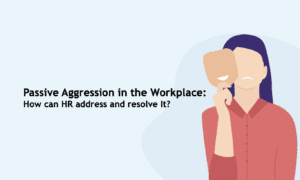Passive Aggression in the Workplace: How can HR address and resolve It?
Passive aggression is a common phenomenon in workplaces that can lead to a toxic and unproductive environment. It involves indirect expressions of hostility, resentment, or dissatisfaction instead of open and direct communication. Dealing with passive aggression is crucial for maintaining a healthy work culture and ensuring effective teamwork. Here, we will explore the impact of passive aggression in the workplace and discuss how Human Resources (HR) can play a vital role in addressing and resolving this issue.
Understanding Passive Aggression:
Passive aggression is a type of behaviour in which people express their anger and frustration indirectly instead of openly addressing it. It can include actions such as subtle insults, sarcasm, procrastination, or avoiding certain tasks that the passive-aggressive person finds unpleasant. People who exhibit this behaviour may be afraid of confrontation or conflict, so they will instead express their feelings through passive-aggressive behaviours.
Passive aggression can have various underlying causes, including:
- Fear of Conflict: Many individuals experience a fear of conflict and worry about the potential negative outcomes of expressing themselves openly. They may anticipate a negative reaction from others, leading them to resort to passive aggression to avoid direct confrontation.
- Difficulty Expressing Emotions: Some individuals find it challenging to express their emotions, particularly anger or frustration. Instead of openly communicating their feelings, they may engage in passive-aggressive behaviour as a means of indirectly venting their emotions.
- Low Self-Esteem: Individuals with low self-esteem often struggle with asserting their needs and wants. They may feel unworthy or fear rejection if they express themselves directly. Adopting passive-aggressive tactics allows them to indirectly communicate their desires or manipulate situations to get what they want.
- Stressful Circumstances: Highly stressful situations, such as a demanding job or a strained relationship, can trigger passive-aggressive behaviour. When individuals are already under pressure, they may resort to passive aggression as a coping mechanism or as a way to assert control in challenging circumstances.
- Introversion and Difficulty with Direct Communication: People who lean towards introversion may find it more challenging to express their needs or desires directly. They may struggle with assertiveness and feel uncomfortable with direct confrontation, leading them to resort to passive-aggressive responses to navigate interpersonal situations.
The Impact of Passive Aggression:
- Passive aggression can lead to decreased productivity as it creates a tense and stressful work environment, making it difficult for employees to focus and perform their best.
- When employees experience passive-aggressive behaviour, their morale and job satisfaction suffer, leading to decreased engagement and motivation.
- Passive aggression can strain working relationships and create a culture of animosity, affecting teamwork and collaboration.
- Employees subjected to persistent passive-aggressive behaviour may seek alternative employment opportunities, resulting in increased turnover rates.
How HR Can Help:
- HR should foster a culture of open and transparent communication, encouraging employees to express their concerns and address conflicts directly.
- Offering conflict resolution workshops or training programs equips employees with the skills to handle conflicts constructively and communicate assertively.
- HR should develop clear policies and guidelines that define acceptable behaviour and provide a framework for addressing passive aggression in the workplace.
- Regular training sessions on topics such as emotional intelligence, effective communication, and conflict management can help employees recognize and address passive aggression.
- Establishing confidential reporting mechanisms, such as suggestion boxes or anonymous surveys, allows employees to report incidents of passive aggression without fear of retaliation.
- HR can act as mediators to facilitate conversations between individuals involved in passive-aggressive conflicts, providing a neutral space for open dialogue and resolution.
- HR should communicate the consequences of engaging in passive-aggressive behaviour, ensuring that employees understand the seriousness of their actions and the potential disciplinary measures that may be taken.
- HR professionals should model respectful and direct communication, demonstrating the desired behaviour for employees to follow.
Conclusion:
Passive aggression in the workplace can have detrimental effects on productivity, morale, and employee relationships. HR plays a vital role in addressing and resolving this issue by promoting open communication, providing training, establishing clear policies, implementing anonymous reporting mechanisms, and facilitating conflict resolution. By actively addressing passive aggression, HR can create a healthier and more harmonious work environment where employees can thrive and contribute their best.

